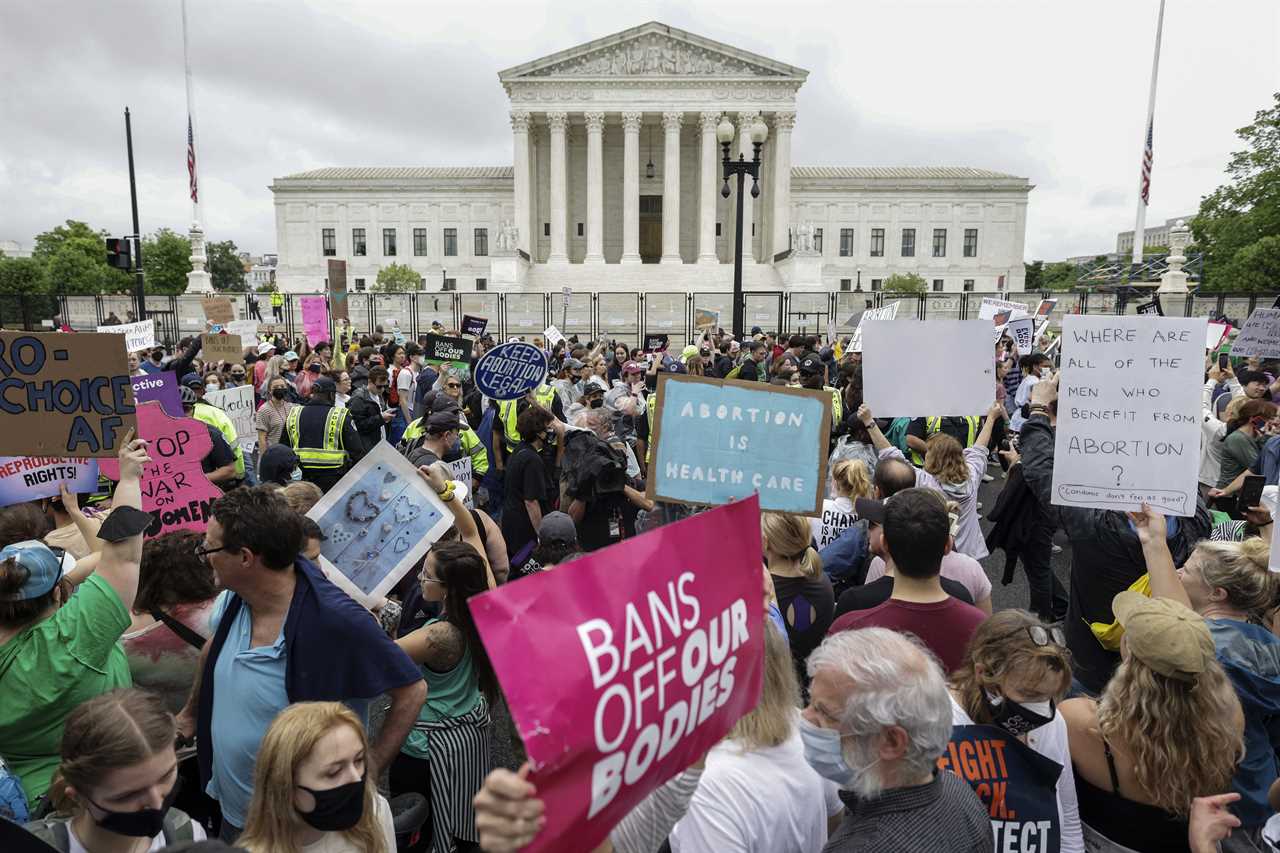
States bracing for a likely flood of patients seeking abortions are changing their laws to allow nurses, midwives and other non-physician health care workers to provide the procedures — and setting aside millions to train the expanded workforce.
Democratic lawmakers and abortion-rights advocates say they are worried that if Roe v. Wade is overturned, their clinics — which are already struggling with pandemic burnout and budget cuts — will be overwhelmed, causing long waits for abortions for in-state residents and travelers alike.
“We are likely going to see a serious increase in our patient load from out-of-state patients within weeks,” said Democratic Delegate Ariana Kelly, who sponsored legislation in Maryland to expand who can provide abortions. “We saw what was happening in states adjacent to Texas, the increased wait times for appointments, and we didn't want that to be what happens in Maryland, both for the sake of patients in Maryland and for the sake of out-of-state patients."
Anti-abortion groups have marshaled their resources to fight against the policy, arguing it puts pregnant people in danger, while some physician groups have also lined up in opposition, complaining about encroachment on their turf.
Abortion-rights groups and progressive legislators counter that allowing non-physicians to handle the simplest and earliest abortions — particularly those that involve prescribing a pill — would free up the existing small pool of trained doctors to handle more complex procedures that usually occur later in pregnancy, improving access across the board. They say it’s one of the most tangible ways states can prepare for a high court decision that could clear the way for roughly half of the country to ban the procedure.
“Just because you have a legal right to certain care does not necessarily always mean that there’s access,” said Dan Rayfield, House speaker in Oregon, where nurses and other clinicians are allowed perform abortions. Oregon recently poured $15 million into a fund that can be used to instruct abortion providers in anticipation of a wave of patients coming over the border from Idaho and other red states.
In Connecticut and Maryland, lawmakers passed bills this spring allowing registered nurses, nurse-midwives and physician assistants to perform medication and procedural abortions. In Delaware, legislators recently approved a bill letting nurse practitioners and nurse-midwives prescribe abortion pills. In Washington state, lawmakers codified an attorney general opinion that allows what are known as “advanced practice clinicians” to provide abortions.
While those policies were in the works ahead of an expected Supreme Court ruling on Roe v. Wade this term, more efforts are now underway in the wake of the draft opinion POLITICO published two weeks ago.
New Jersey Gov. Phil Murphy is pushing lawmakers to create a “reproductive health access fund” with grants to train abortion providers and enact legislation that cements existing rules allowing advanced practice clinicians to perform abortions. And California Gov. Gavin Newsom released an amended budget proposal on Wednesday that includes an additional $57 million to prepare the state’s clinics to absorb an increase in patients seeking abortions.
Advocates believe the policies will allow abortion-supportive states to start shoring up their networks of providers.
But a swath of challenges remain.
Anti-abortion-rights groups like Students for Life of America and the American Association of Pro-Life OB/GYNs have mobilized to fight these state laws, sending people to testify against them and lobbying legislatures to oppose them.
In Maryland, Republican Gov. Larry Hogan recently vetoed the bill to allow non-physicians to provide abortions, arguing the policy “endangers the health and lives of women” and “risks lowering the high standard of reproductive health care services.” When the legislature overrode that veto, Hogan withheld the $3.5 million appropriated to the new abortion provider training fund, hampering efforts to start teaching non-physicians when the law is implemented this summer.
The Connecticut State Medical Society also criticized their state’s move, testifying to the legislature in March that the policy would have “unintended consequences.”
“We head down the slippery slope to allowing those procedures that are in fact surgical to be done by mid-level providers, creating patient safety concerns and significant scope of practice issues,” they wrote.
Yet many individual physicians and medical groups have embraced the expansion of who can provide abortions, including the World Health Organization, the American Public Health Association and the American College of Obstetricians and Gynecologists.
“I have spent a decade training to be where I am today, but I also recognize that the majority of abortions in the U.S. happen in the first trimester and are uncomplicated,” said Lauren Thaxton, an abortion provider and researcher at the University of Texas at Austin. “We also have plenty of data to say that the health care outcomes among people who have advanced practice clinicians who provide abortion care are similar to people who have doctors.”
Roughly 10 percent of the nation’s abortion providers practice in the 23 states poised to immediately ban most, if not all, abortions if Roe is overturned, according to the Guttmacher Institute’s last abortion provider census in 2017.
Of the remaining states, 18 allow non-physicians to perform abortions, either by law, regulation, court case, attorney general opinion or board of nursing decision, according to Guttmacher and a POLITICO review of state policies.
Though many low-income patients might not be able to travel for the procedure if the Supreme Court allows sweeping bans, Thaxton and other researchers worry not enough states are ready to handle the volume of patients who can and will make the trip.
Planned Parenthood, for example, reported that after Texas’ six-week ban took effect in September, there was an 800 percent increase in patients seeking abortions in surrounding states. Now, many of those same states are set to enact bans.
“I worry about how this will look when care is restricted in more states than one,” Thaxton said. “How will all of that patient care get absorbed? I worry that will create delays in care that are unsafe.”
Longer wait times
Those delays are set to hit blue state residents as well as those traveling from states that ban abortion, especially those living in rural areas with few or no clinics. Unless the provider workforce is expanded quickly, progressive advocates fear they could push patients past the window where they can legally get the procedure. Abortion pills are only approved by the FDA for use within the first 10 weeks of pregnancy, and several blue states, including California and New York, only allow procedural abortions up to the point of fetal viability, which generally occurs around 24 weeks of pregnancy.
Washington state, for instance, is expecting a 385 percent increase in patients seeking abortion from Idaho and other nearby states if Roe is overturned, according to the Guttmacher Institute.
“If we aren’t prepared for what’s going to happen … the inequities that we see when access to reproductive care is not available for everybody will be exacerbated, and that has already historically excluded communities,” Kia Guarino, executive director of Pro-Choice Washington said.
Furthering the crunch, states like Maine and Kansas have laws on the books saying that only a physician can perform an abortion. Others, such as Pennsylvania and New Jersey, have laws saying that nurse practitioners can only work under supervision by a doctor — not just for abortions but for many kinds of procedures.
Medical groups have for decades fought state attempts to change these laws and give non-physicians permission to take on duties previously restricted to their members — from prescribing painkillers and antibiotics to ordering x-rays.
Yet most of the opposition to the expansion of the workforce has come from anti-abortion-rights advocates.
“Name another medical procedure where the goal is for someone with a lower skill level to be in charge of your health,” said spokesperson Kristi Hamrick with the group Students for Life of America, which has recently fought bills in Maryland and other states. “This shows that women’s health is of no consequence to them whatsoever.”
The University of California at San Francisco concluded after a 6-year study that first-trimester abortions are equally safe whether performed by a doctor, a nurse practitioner, a midwife or a physician’s assistant. More than 90 percent of abortions in the U.S. take place in the first trimester.
Too little training
Among the problems facing states moving to allow other medical workers to perform abortions is a lack of clinical training for the majority of nurses, midwives and other advanced practice clinicians.
Most medical training programs include little to no instruction on abortion. Many hospitals are religiously affiliated and refuse to teach their workers how to perform one. And the country’s few trained abortion providers are already so overburdened by the number of patients that they have little time to teach others.
Julie Jenkins, a nurse practitioner finishing her doctorate at Johns Hopkins University, works with the Reproductive Health Access Project, which is trying to address these knowledge gaps.
“These providers have already put in IUDs. They’ve done endometrial biopsies. This isn’t a heavy lift for them,” she said of the nurses and midwives she’s been coaching. “But they still need to be trained, and that’s where we run into a lot of problems.”
The fear of a coming provider shortage has pushed several states to allocate new funding for training.

Lawmakers in Oregon this spring established a $15 million Reproductive Health Equity Fund, some of which will be used to train more abortion providers. And New York Gov. Kathy Hochul directed the state’s Department of Health last week to set aside $35 million to create an Abortion Services Provider Fund.
But where state funding has fallen short, medical workers and advocates have had to get creative, holding Zoom trainings, creating online curricula and pairing nurses and doctors together to shadow abortion procedures.
The Bixby Center for Global Reproductive Health has developed a workshop now used across the country for teaching early abortions using a papaya, the inside of which closely resembles a uterus.
“It’s a manual vacuum aspirator that you insert into the neck of the papaya and move it around until all the seeds and pulp are out, and you can feel on the walls of the fruit when it’s complete,” Jenkins explained. “It’s a great way to help people understand what’s going on, and demystify and destigmatize this for people.”
----------------------------------------
By: Alice Miranda Ollstein and Megan Messerly
Title: Blue states expand who can provide abortions as they brace for a flood of patients
Sourced From: www.politico.com/news/2022/05/17/states-expand-abortions-flood-of-patients-00032815
Published Date: Tue, 17 May 2022 03:30:00 EST






